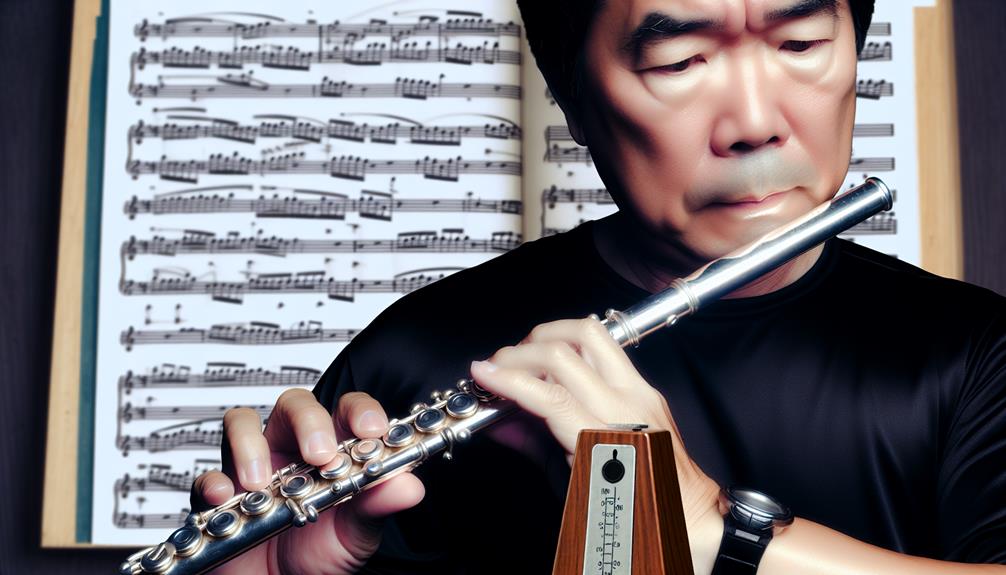Mastering the flute is often considered a formidable challenge among musicians due to its unique set of complexities. Beyond the intricacies of demanding breath control and complex fingerings, the instrument requires a level of precision in embouchure techniques that few others can match.
Add to this equation an intensive practice regimen to navigate the nuances of tone production, and the flute emerges as a formidable contender in the realm of musical instruments.
Yet, there is one aspect that sets it apart from the rest, an element that truly distinguishes it as the pinnacle of musical finesse – a secret known only to those who dare to conquer its enigmatic essence.
Key Takeaways
- Demand for unparalleled breath control.
- Precision in complex fingerings and intonation.
- Mastery of precise embouchure techniques.
- Intensive daily practice regimen for mastery.
Demanding Breath Control
Mastering the flute requires unparalleled breath control, distinguishing it as one of the most challenging instruments to play. The ability to produce clear and consistent tones on the flute relies heavily on the player's breath control. Unlike many other instruments, where sound is produced through various methods like plucking, striking, or bowing, playing the flute demands a continuous flow of air controlled by the musician's diaphragm and embouchure. This level of control is essential for achieving the desired pitch, tone, and dynamics.
Furthermore, breath control in flute playing is not just about sustaining long notes but also involves nuances like dynamics, articulation, and phrasing. Players must master techniques such as vibrato, staccato, and legato to add depth and emotion to their performances. This intricate balance of airflow and pressure requires precision and practice to achieve mastery.
In essence, the demanding nature of breath control sets the flute apart as a challenging instrument that requires dedication, discipline, and a profound understanding of one's respiratory system. Aspiring flutists must commit to honing their breath control skills to unlock the instrument's full potential and deliver captivating musical performances.
Complex Fingerings
Navigating the intricate fingerings of the flute demands meticulous precision and dexterity from the musician. The complexity of the fingerings on the flute contributes significantly to why it is often considered one of the most challenging instruments to master. Here are three reasons why flute fingerings are so complex:
- Multiple keys and combinations: Flute players must memorize a vast array of fingerings, including various combinations of keys and intricate patterns. This requires hours of practice to develop muscle memory and fluidity in transitioning between different finger placements.
- Half-holing and alternative fingerings: Unlike many other instruments, flutists often need to use techniques like half-holing or alternative fingerings to produce specific notes accurately. Mastering these techniques is essential for achieving a clear and precise sound.
- Micro adjustments for intonation: Flutists must make micro adjustments to their fingerings to ensure proper intonation across different registers. This attention to detail is crucial for playing in tune and producing a harmonious sound.
Precise Embouchure Techniques
The intricate nature of flute playing extends beyond complex fingerings to encompass the precise embouchure techniques required for achieving optimal tone production and control. The embouchure refers to the way in which the player shapes their lips and uses air to produce sound on the flute.
Achieving a clear and resonant tone on the flute is heavily dependent on mastering these precise techniques. Proper embouchure involves finding the right balance of lip tension, airspeed, and direction to create a rich and focused sound. This requires a keen sense of control and finesse, as even minor adjustments in the embouchure can drastically affect the tone quality.
Developing a strong embouchure also allows the flutist to navigate the instrument's range with ease and accuracy. Through dedicated practice and attention to detail, flutists can hone their embouchure techniques to unlock the full potential of their instrument, ultimately leading to a more expressive and polished performance.
Intensive Practice Regimen
Developing a disciplined practice routine is essential for enhancing proficiency and skill acquisition in flute playing. To master the intricacies of this challenging instrument, flutists should consider the following key elements in their intensive practice regimen:
- Consistent Daily Practice: Regular practice sessions, even if short, are more effective than infrequent, lengthy sessions. Consistency is crucial for building muscle memory and developing a strong foundation.
- Focused Attention on Technique: Concentrating on proper hand positioning, breath control, and finger dexterity during practice sessions can lead to significant improvements in overall playing ability.
- Utilizing Practice Tools: Incorporating tools such as metronomes, tuners, and recordings of professional flutists can help in refining intonation, rhythm, and tone quality. These tools provide valuable feedback for self-assessment and improvement.
Nuances of Tone Production
How can flutists refine their tone production to achieve a higher level of musical expressiveness and clarity? The nuances of tone production on the flute are essential for creating a rich and captivating sound. To achieve this, flutists must pay careful attention to their embouchure, air support, and articulation.
First and foremost, a flutist must develop a strong and flexible embouchure. The embouchure is the position of the lips, lower facial muscles, and jaw when playing the flute. By maintaining a stable and well-formed embouchure, flutists can produce a clear and resonant tone.
Additionally, proper air support is crucial for controlling dynamics and sustaining long phrases. Flutists must learn to engage their diaphragm and use steady air pressure to create a consistent sound across all registers of the flute.
Frequently Asked Questions
What Are Some Common Misconceptions About Playing the Flute That Beginners Might Have?
Beginners often have misconceptions about playing the flute, such as believing it requires minimal effort or that it produces a soft sound. In reality, mastering the flute demands patience, dedication, and proper technique to produce clear and resonant notes.
Beginners might also underestimate the breath control required and the finger dexterity needed to navigate the instrument's complex key system. Understanding these challenges and approaching flute playing with a mindset of continual learning is essential for progress.
How Does the Physical Size and Shape of a Person's Mouth and Lips Affect Their Ability to Play the Flute?
The physical size and shape of a person's mouth and lips can significantly impact their ability to play the flute. A larger mouth may struggle with tight embouchure formation, affecting control and tone production.
Conversely, a smaller mouth might find it challenging to achieve the necessary flexibility for intricate techniques. Proper guidance and practice can help individuals overcome these obstacles, ensuring that all aspiring flutists can reach their full potential regardless of their anatomical characteristics.
Are There Any Specific Health Concerns or Risks Associated With Playing the Flute That Players Should Be Aware Of?
Playing the flute can pose specific health concerns that players should be mindful of.
Prolonged incorrect posture or repetitive movements may lead to musculoskeletal issues. Additionally, excessive tension in the neck, shoulders, or jaw can result in discomfort or even injury.
Proper warm-up exercises, regular breaks, and seeking guidance from a qualified instructor can help mitigate these risks and promote overall well-being for flute players.
What Are Some Common Challenges That Flute Players Face When Transitioning From Beginner to Advanced Levels?
When transitioning from beginner to advanced levels, flute players commonly face challenges related to:
- Breath control
- Embouchure precision
- Intricate fingering techniques
These aspects require a higher level of coordination and skill refinement to master the nuances of advanced repertoire.
Additionally, tackling complex rhythms, mastering intonation in various registers, and developing a refined tone quality are key milestones that demand dedicated practice and perseverance for flute players progressing to higher skill levels.
How Does the History and Cultural Significance of the Flute as an Instrument Impact the Way It Is Taught and Played Today?
The history and cultural significance of the flute have shaped its teaching and playing methods today. The flute's rich heritage influences the repertoire, techniques, and styles taught. Understanding the instrument's roots can provide insights into its unique characteristics and playing requirements.
Teachers often incorporate historical contexts into lessons, fostering a deeper appreciation for the flute's cultural impact. Embracing the historical and cultural aspects of the flute can enhance the overall learning experience for students.
Conclusion
In conclusion, the flute is considered the hardest instrument due to its demanding breath control, complex fingerings, precise embouchure techniques, intensive practice regimen, and nuances of tone production.
Mastering the flute is like navigating a labyrinth, requiring dedication, discipline, and patience to achieve proficiency.

